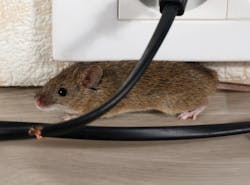With the recent Polar Vortex in the Midwest, it’s hard to think about spring. But it will be here one of these days.
As springtime approaches, the season not only brings warmer temperatures, it also signals the rise of insects and wildlife — awake from their winter slumber and on the lookout for food, shelter and water. And that’s exactly what your building can offer them.
“It depends on where you are in the country; every region’s going to have something different,” says Chelle Hartzer, technical services manager for Orkin, a residential and commercial pest control service. “In the spring, we see a lot more activity with small mammals that are starting to become more active and looking for food and friends.”
Again, it varies depending on your location, but typical springtime pests include ants, flies, small rodents (mice, rats) and spiders. “As temperatures rise, ant colonies start to forge a bit more,” Hartzer explains, “and they start to look for more food sources.”
To avoid the intrusion or infestation of pests, facilities managers should do the following:
1. Monitor points of entry (anything that connects the inside of your building to the outside).
Look at doors to make sure the bottom door sweep is sealed tightly to the ground. In larger facilities, check for the same tightness on dock or garage doors to make sure nothing can get in through those spaces.
HVAC units, vents and pipes can also serve as entry points for pests and help them travel throughout your facility, which means having a building plan handy can help you track anything that might enter.
BUILDINGS Podcast
RELi: The Building Resilience Standard Focus
[podcast]
Doug Pierce, director of Perkins+Will Resilience Research Lab explains the requisites for RELi that are focused on things like climate change and adaptation, improving biodiversity, and social equity and social cohesion topics. Listen now >>
“Around the perimeter of the building, openings, cracks or open doors are open invitations to pest getting inside the property,” says Marc Potzler, technical services manager for pest control service Rentokil North America.
“Around loading docks, where birds tend to seek shelter from the elements, along with open dock doors, which can invite rodents…can be harbor points for a variety of insects,” he explains.
2. Keep your landscape neat and trimmed.
“One of the things facilities managers can do a great job with is looking at the landscape and making sure those trees are trimmed back from the building,” Hartzer says. “If they’re touching the building, that’s a pathway for those pests to get in. Make sure you don’t have large tree branches touching the building or giving access to the roof—that’s a big one.”
Pay attention to shrubs and bushes as well. Keep them from becoming overgrown and bushy. “That’s a perfect habitat for those small rodents, those mice and rats, so keeping them trimmed back means it’s a little less friendly and hospitable. They’ll go somewhere else,” Hartzer explains.
[Read also: Difference Between Facility and Property Managers]
3. Work closely with pest control services.
You and your pest control service can share experience and knowledge to help prevent or eliminate pests from invading your building.
“Pest management professionals can use their experience to say, ‘OK, they’re probably getting in through here’ or ‘we have extra pressure on this side of the building, so keep an eye out,’” Hartzer says.
“And facilities managers can lend their experience to say, ‘this is where the building connects to over here’ or ‘this is where this pipe goes’ so the pest management professional can keep an eye out on some of those areas that they know are going to be an issue,” Hartzer continues.
4. Sanitize areas where people consume or dispose of food and beverages.
All living things need food and water—so the areas of your building where food and drink are consumed can be prone to pest invasions. Regularly sanitize these areas and empty trash bins and dumpsters often, and situate your dumpsters at a distance from any of your facility’s points of entry.
[Related: Dwell Time: Are Your Disinfectants Actually Working?]
“Educating [tenants] about the importance of keeping doors closed, maintaining proper sanitation and keeping a watchful eye out for signs of pest activity will go a long ways toward reducing pest activity in the building,” Potzler says.
Although your facility is appealing to springtime pests that are forging for food, water and shelter, follow these preventive maintenance tips to avoid a full-blown infestation.
Preventive Maintenance Checklist
Download this checklist to keep major building systems – HVAC, roofing, plumbing and lighting – in good working order.
With proper preparation, Hartzer says, “Those pests will realize this is not a good, happy place to be, and they’re going to go elsewhere—which makes everybody’s job a little bit easier.”
Two handpicked articles to read next:
About the Author

Sarah Kloepple
Associate Editor
Sarah joined the BUILDINGS team as an associate editor in August 2018. She is a graduate of the Missouri School of Journalism, where her focus was magazine writing. She's written and edited for numerous publications in her hometown of St. Louis.
